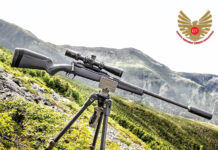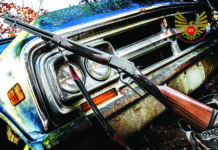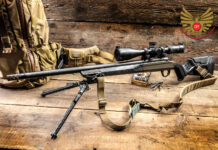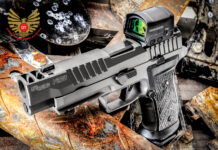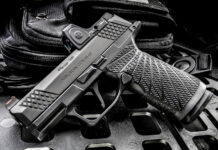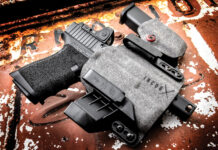Range Time
Compensating low velocity cartridges like the .45 ACP has always been controversial. Ports and compensators tend to work better the hotter the ammunition, not something typically thought of with the mighty .45. Well, times have changed, with several stout loads suitable for factory pistols. Having tested a similar pistol in a couple different schools over the last year, these loads have proven excellent. Barnes TAC-XPD uses a 185-grain bullet at 1.000 f.p.s.; Doubletap’s 185-grain bonded load makes over 1,100 f.p.s. from this barrel. They also make a 160-grain load using the Barnes TAC-XP bullet that measured 1,150 f.p.s. Ballistics testing on these loads has been impressive, but they are a handful out of a standard pistol, making the compensator very helpful.

Even the slowest of the loads tested was noticeably softer through the Firehawk. Accuracy was excellent, with my best group being accomplished using the Barnes 185-grain TAC-XPD. My best group measured a bit under 1.5 inches at 25 yards. Nothing was outside 2.0 inches at 25 yards. including the hottest loads. Doubletap’s 160-grain TAC-XP was pretty much POA/POI at 25 yards with a slightly higher hold at 50 yards. This load shot flat (and so does this pistol) and is my go-to .45 ACP carry load. Overall, muzzle rise is noticeably tamed—especially during rapid fire at close range—and offered similar recoil characteristics to a standard 4-inch 9mm 1911. Cutting a single hole at 10 yards is pretty easy with this pistol, as are fist-sized groups on the move. A gold bead front sight sits atop all my carry 1911s. It’s my favorite, but probably is not for everyone. In the right light they are easy to see (shaded not so much), but they will not break or typically fall out. Not to worry, however. If you prefer you can order the Firehawk with either a fiber optic or tritium front sight.
Pistols are all about slide timing when it comes to proper operation. Adding weight to the muzzle end and compensation can really mess with reliability. Loads from 230grain hardball to the hottest lightweight loads all ran perfectly with several different magazines. Slower ammunition resulted in a slight but noticeably slower slide speed and less enthusiastic ejection, but it ran it all locking open on the last round. Adding aftermarket compensators seldom yields these kinds of results, a testament to building a pistol ground up, and Nighthawk’s attention to detail with the Firehawk.
Considerations
This pistol is loud. Physics apply and sending a blast straight up makes it louder. At arm’s length it’s not bad, but move closer to a position of retention and you notice and feel it. Oppressive? Not really, but noticeable for sure. Would it interfere in a fight? Depends on who you are and the fight, but it is something to be aware of. Whether you will see any debris is more about the ammunition. Cheap reloads using dirty powder will probably spray you a bit, none of the carry ammunition tested pelted me with anything. Same thing is true when it comes to flash. Hornady’s 220-grain Critical Duty had no flash to speak of, same with the Federal HST, Doubletap and Barnes. Quality duty or carry ammunition uses low-flash powders by design. Practice ammunition not so much—a noticeable ball of flame was common. Just the facts of life with any pistol. Compensated models just send it in a different direction.

All my testing was completed using my Simply Rugged dress holster and magazine pouch, which seemed appropriate using a pistol costing $4,000, and it looked really nice. Fit was perfect along, as were my Milt Sparks, Mitch Rosen and four or five other full-size 1911 holsters. If you carry a full-size 1911, this will feel exactly the same, including the weight. Loaded carry weight is in the 45- to 47-ounce range depending on ammunition and whether you carry 8+1 or only 8 rounds. Use a solid, well-built holster and thick, purpose-built belt for the greatest security and comfort. Having carried full size 1911’s for 30 years, the right carry rig is well worth the investment.
Page 3


